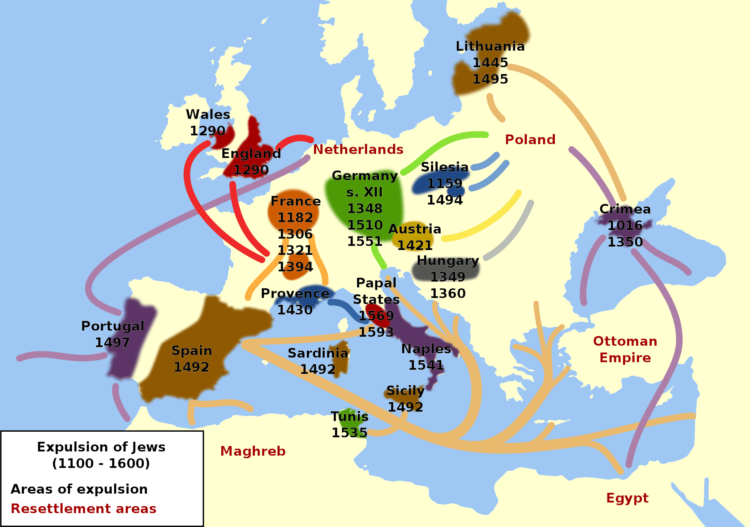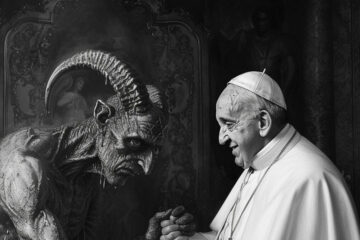Jewish Merchants of Sin and Porn, part 1: The Battle Begins
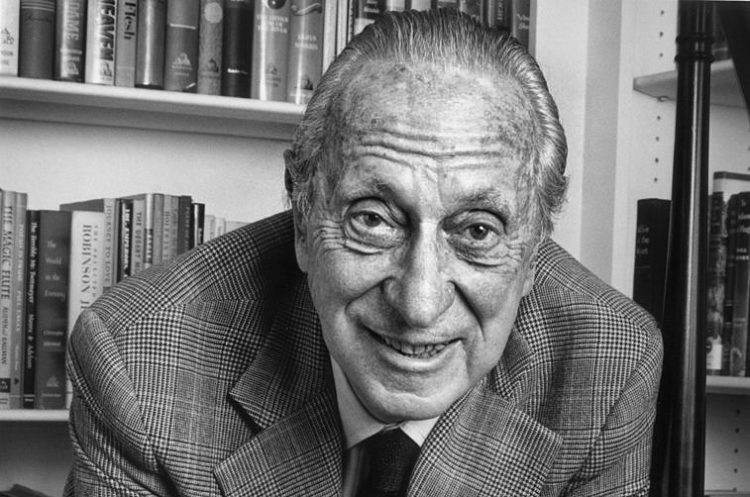
by Benjamin Garland
NOTE: All parts of this series may be found here.
THE JEWS NEVER FACED much anti-Semitism in America. This is due, in large part, to the underlying ideologies it was founded on; namely, universalistic interpretations of Christianity and Enlightenment ideals of freedom, equality and opportunity for all.
These principles, which were arguably created with noble intent – and based on the values inherent in a society of European-descended peoples of high moral character – crippled the defenses of the individualistic-minded White natives and gave the Jews free rein to consolidate power at a rather alarming rate, virtually unchecked.
The Jews began emigrating to the United States in waves around 1880, when their population was only about 250,000. Within a decade that number was nearly double, and by the 1930s it had shot to 3 to 4 million.
Many of these immigrants – if not most – were Eastern European Jews of the nastiest sort, and they immediately became vastly overrepresented among criminals and subversives.
A 1908 police commissioner report shows that while the Jews made up only a quarter of the population of New York City at that time, they were responsible for 50% of its crime.1
One of their more common criminal activities has always been the sale and promotion of pornography and smut.
Two quotes should suffice in backing up this assertion, one from an anti-Semite, and one from a Jew.
Firstly, an early opponent of the Jews in America, Greek scholar T.T. Timayenis, wrote in his 1888 book The Original Mr. Jacobs that nearly “all obscene publications are the work of the Jews,” and that the
historian of the future who shall attempt to describe the catalogue of the filthy publications issued by the Jews during the last ten years will scarcely believe the evidence of his own eyes. Scenes of gross debauchery, representing drunken monks in the society of girls, priests lashing nude women, filthy groups, and other outrageous pictures, are displayed on all sides, with Jewish effrontery, in the windows and stores.2
One such “historian of the future,” Jay Gertzman, who is himself Jewish, and quite proud of his tribe’s historic role in peddling obscenity in America, wrote in his 2004 book on that topic, Bookleggers and Smuthounds, that
Jewish erotica dealers seem to have become prominent in the field soon after the eastern European immigrants began arriving in record numbers in 1880. The best evidence of this, apart from the name of offenders as reported in newspapers, are the listings in the yearly ledgers of the NYSSV [New York Society for the Suppression of Vice]”3
Gertzman supplies a chart of those who were arrested for obscenity by religion, based on the NYSSV records between the years of 1882 and 1939.
The chart shows a consistent disproportion of Jews, and culminates in the shocking and revealing 1939 statistic of 28 Jews, 2 Catholics, and 0 Protestants. He further notes how the figures “may be skewed” regarding Jewish involvement, given that “the ‘religion’ column was left blank fairly often.”4
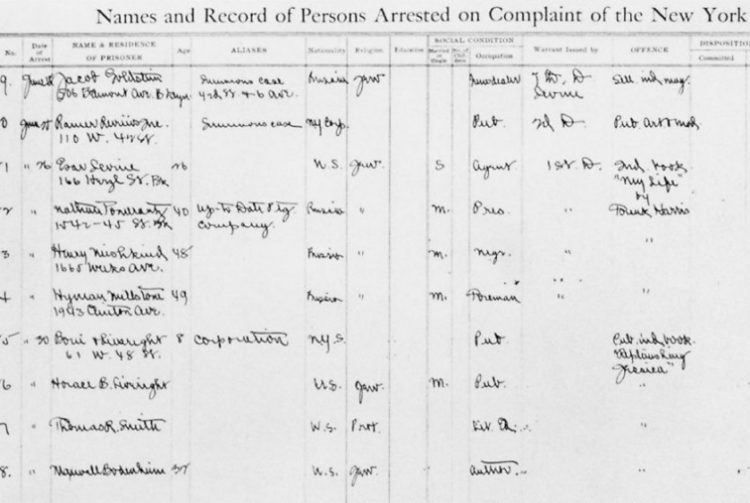
The above should come as no surprise though, as it is a fairly well known fact that pornography in our current day is almost exclusively a Jewish business (see part 9).
The difference between then and now, though, is that back then it was illegal to peddle smut in this country – and the laws were enforced – while now our society is saturated in it, and the pornographers are almost never prosecuted.
This is due to a series of landmark liberalizing court cases over obscenity during the past century, along with a general loosening of the attitude on sexual morality, both of which the Jews have played a very heavy hand in.5
What follows in this series of articles is a brief history of this process, in order to give the reader an idea of how we got from then – when traders in pornography were seen and treated as the lowliest of criminals – to now – where the hardest of hardcore porn is accepted to the point where even children have instant access to it with their laptops and smartphones.
Now, while there were of course many other crucial elements that helped bring about the climate in which the liberalization of these laws could take place, the role of Jews can hardly be overstated. They were, if not the most important factor, certainly a necessary and decisive one.
We will see that essentially there has been a war going on between Whites and Jews, with Whites struggling to maintain a clean and decent society, and Jews fighting to make filth and obscenity acceptable – a war which Whites have thus far been losing, miserably.
In order to deal with a problem, I believe, it is necessary to locate its source, in order to pull it out at the root, and it is my assertion that the root of our problem with pornography is the toleration of Jews in our midst, and our failure to fight against their collective criminal and subversive tendencies on a racial basis.
By this I mean dealing with them as Jews, as a group, rather than just a collection of individuals, some bad, some good.
They themselves operate as a cohesive group and perceive us as an enemy, and act accordingly with deliberate, calculated attacks designed to weaken us and our civilization, as what weakens us morally in turn gives them more power.
This has even been admitted by Jews themselves, in moments of candor. Dr. Nathan Abrams, for instance, wrote in the Jewish Quarterly that Jewish involvement in the sex industry is “the result of an atavistic hatred of Christian authority: they are trying to weaken the dominant culture in America by moral subversion.”6
This is part of an evolutionary strategy the Jews have adopted over millennia, having spent the majority of their history functioning as a race of parasites, feeding off of the resources of whichever unfortunate peoples they were living among at any given time.
This well-documented parasitism and hostility of the Jews has gotten them kicked out of European countries well over 100 times in the past. They are all well aware of this fact, and will do whatever is necessary to ensure it never happens again.
Along with being a power grab/survival strategy, another clear motivational factor is, of course, simply economical.
Pornography has by far one of the highest profit margins of any business venture, making it the perfect occupation for those lacking a moral objection to it.
The sale of vice exploits man’s weaknesses, destroys families, and lowers the moral fabric of society, all to the great benefit of a tiny minority of unscrupulous and sleazy men. This is obvious, and is why there has been – and needs to be – restrictions in place in order to prevent it.
The Battle Begins
“American Jewry . . . has been overwhelmingly antipathetic to the crusade for morality and censorship in the arts and literature.” – Leo Pfeffer7
The first concrete federal anti-obscenity law in America was formulated in 1873. It was called the Comstock Act, and it prohibited the use of the U.S. Postal Service for sending obscene materials.
The law came following an upsurge in pornographic pictures among homesick soldiers in the Civil War, and was cemented as the basis for obscenity regulation in 1896 after the Supreme Court upheld the conviction of Lew Rosen, a Jew who had been arrested for mailing the publication Broadway, which featured nude images hidden under a spot that could be wiped away with a piece of bread.
The Comstock Act had been written and passed through congress through the lobbying efforts of Anthony Comstock, and marked the beginning of the New York Society for the Suppression of Vice, of which Comstock was the head until his death in 1915, when he was succeeded by John S. Sumner.
Whether or not an item was obscene was thereafter determined by what was known as the Hicklin test, derived from the 1868 English obscenity case Regina v. Hicklin.
The criteria of the Hicklin test deemed as obscene anything tending “to deprave and corrupt those whose minds are open to such immoral influences.” Children, degenerates, and criminal elements prone to be negatively influenced by such material were who was in mind with this test.
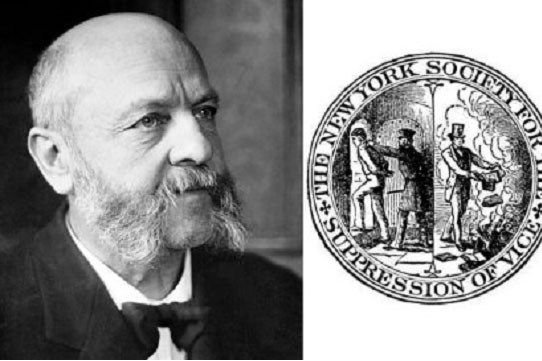
A flood of obscene literature coupled with ever-intensifying intellectual challenges to the validity of obscenity law increased over the succeeding decades, concurrent with the burgeoning Jewish population, finally resulting in a backlash in the form of the ‘clean books’ crusade of the 1920s.
New York Judge John Ford founded the Clean Books League in 1923, after it was brought to his attention that his sixteen-year-old daughter had come across some unsettling passages in a book she had acquired from a Manhattan book dealer.
Ford, while able to find much support for his campaign among the Catholic and Protestant citizens was, as he lamented, “unable to interest Jewish organizations.”8
Sumner, now head of the NYSSV, personally introduced the “Clean Books” bill in 1923. It was defeated, pretty much singlehandedly, by the Jew Horace Liveright.9
The bill was subsequently introduced and defeated each year until 1929, when it finally fizzled out.
Support in favor of strict obscenity regulation had reduced drastically by this time. In Comstock’s day, as Paul Boyer writes in his study on the history of obscenity laws, Purity in Print, the membership of vice societies read like a veritable “Who’s Who of the day” among the WASP elite.10
One of the primary causes for the decline in support for obscenity regulation among the White elite was the rise of a Jewish media elite (all of the major publishing houses to directly challenge the NYSSV and the Comstock act in the 20s, 30s and 40s – and indeed almost all major publishing houses in general by that time – were Jewish owned, or at least heavily staffed by Jews).
Much like today, where any and all opposition to the Jewish and liberal agenda is silenced through charges of “racism,” “bigotry,” “hate,” “anti-Semitism,” etc., supporters of obscenity regulation were ridiculed in the media with epithets such as “prude” and “puritan,” while their opponents were portrayed as heroic crusaders for freedom of expression.
Attorney Richard Kuh, who himself faced a barrage of these insults for daring to prosecute obscenity cases, put it this way in his book Foolish Figleaves:
“Constitution,” “Bill of Rights,” and “Free Speech” are all good words, words that create a Spirit of ’76 feeling. Words such as “Censorship” and “Bluenose” are quite the opposite; they afford appropriate targets for hissing and hooting.11
On the legal front, the obscenity battle increasingly came to be fought on constitutional grounds. That obscenity law may be a violation of the First Amendment, became the argument.
In her book How Sex Became a Civil Liberty, Leigh Ann Wheeler pinpoints the team of lawyers at the American Civil Liberties Union (ACLU), led by the Jew Morris Ernst, as the ones responsible for initially transforming this argument from a laughable one – as the First Amendment was clearly written to protect political ideas, not obscenity – into an especially formidable and effective strategy.
Wheeler, drawing on extensive research into the minutes of ACLU meetings, explains that this was not their honest interpretation of the First Amendment, but rather was a deliberately concocted propaganda tool – a means to an end:
ACLU leaders did not simply discover the true meaning of the U.S. Constitution. Rather, they created that meaning in a long and painstaking process of negotiation and collaboration that resembled not so much scales falling from the eyes of the blind as stones being laid and turned this way and that to build a meandering path of uncertain destination.12
The ACLU was started in 1920 by the gentile Roger Baldwin, in response to his being jailed by the US government for being a “conscientious objector” to World War I, which he saw as a violation of his rights to free speech. The organization soon became dominated by radical Jews, and remains so to this day.
Wheeler notes that while Baldwin and other gentile board members such as Mary Ware Bennett and John Haynes Holmes “tended to support laws that maintained boundaries between public and private and to tolerate bans on public sexual expression that did not, in their opinion, address issues of public concern,” other board members, such as Elmer Rice, Morris Ernst and Arthur Garfield Hays – all Jews – “were more concerned about protecting freedom of expression and public access to it,” i.e., the right to openly buy and sell obscene material.
The former position is arguably in line with the actual purpose of the First Amendment, while the latter is a blatant perversion of it.13
In 1928, Ernst published To The Pure, the book that, as Samuel Walker writes in his history of the ACLU, “framed the main ideas of the anticensorship campaign for the next forty years.”14
To The Pure made Ernst the most famous lawyer in the fight against obscenity laws and put him and his fellow Jewish lawyers of the ACLU and his law office Greenbaum, Wolff & Ernst, on the frontline of every major obscenity case from then on out.
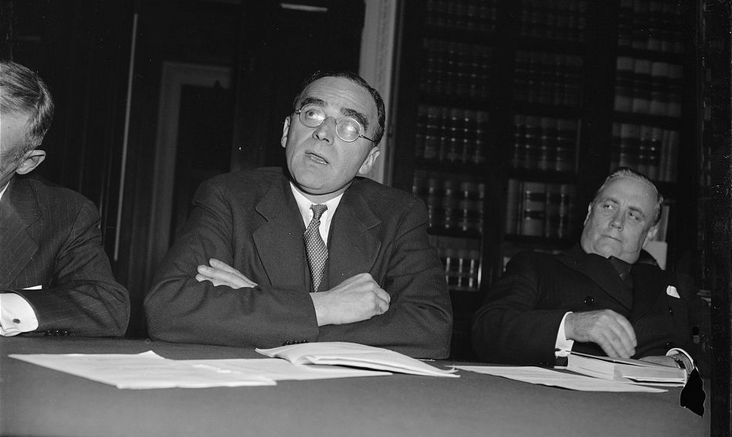
The first landmark victory for the anti-obscenity law activists was the clearing of the importation of the infamous banned book Ulysses by James Joyce.
Seeing dollar signs, and knowing there was a good chance of convincing a court to allow the book because of the changing times and the fact that Ulysses was already regarded as a classic by many, Jews conspired to intentionally get a copy of Ulysses seized by U.S. Customs authorities.
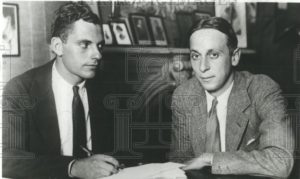
The Jewish owners of the publishing company Random House, Donald Klopfer and Bennett Cerf, told Ernst that if he would represent them and the book they would pay all of the court costs, and that if Ernst won he would get a royalty on Ulysses for the rest of his life.
Ernst readily agreed to this plot, and in addition wrote an introduction to the book, which ultimately earned him hundreds of thousands of dollars in royalties.15
Ernst, with the help of other like-minded attorneys, was able to maneuver the case into the court of the most liberal judge in the New York Circuit, using a series of deliberate postponements.
James Woolsey, the liberal judge, cleared the book as expected. The reason given for his decision was that the book didn’t act like an “aphrodisiac” (i.e. it didn’t make him horny reading it), and his decision significantly altered the criteria of the Hicklin test from “young and susceptible” readers to the “average” person.16
While slightly liberalizing alterations to the accepted obscenity standards did continue apace in the lower courts, in addition to the Ulysses decision, it would be over two decades before a major ruling would come out of the Supreme Court: the infamous Roth v. United States ruling of 1957, which would make the definition of obscenity so broad as to allow just about anything.
In the interim, there was one big obscenity case decided by the Supreme Court, which was regarding the suppression of the book Memoirs of Hecate County, in 1948. The ruling was upheld by a split 4-4 vote (Justice Frankfurter recused himself on the grounds that he was friends with the author, Edmund Wilson), marking a crushing defeat for the anti-obscenity law crowd and one last big win for Sumner, who died two years later, in 1950.
Also in 1948, was the case of Winters v New York, which was in regard to the 1943 arrest of a Jew, Murray Winters, for selling an offensive comic book. The Supreme Court overturned the case with a 6-3 majority, on the grounds that the law, which called for the suppression of “a magazine principally made up of news stories of criminal deeds of bloodshed or lust,” was overly “vague and indefinite.”17
In part 2, we will explore the the fascinating story of the struggle over comic-book censorship that took place between 1948 and 1955, and the Jewish involvement in that, before getting into the 1957 watershed obscenity decision of Roth v. United States, in part 3.
NOTE: All parts of this series may be found here.
If you enjoyed this series, please consider tipping the author. A considerable amount of time and money was spent on writing and researching it.
You can also support this work by purchasing a print copy.
Btc address: 14KQkvSS26QbY264yLXK586GuYZkmM7BS4
Notes
- Police Commissioner Theodore A. Bingham, “Foreign Criminals in New York,” The North American Review, Volume 188, September 1, 1908, p.385
- T.T. Timayenis, The Original Mr. Jacobs, 1888, p.289
- Jay A. Gertzman, Bookleggers and Smuthounds: The Trade in Erotica, 1920-1940, 2001, p.28
- Ibid, p.28-29
- Josh Lambert wrote on p.18 of his 2009 dissertation Unclean Lips: Obscenity and Jews in American Literature: “If one were to ask a lawyer or legal historian to list the five or ten most important cases on the question of obscenity decided by the U.S. Supreme Court before 1980, for example, the resulting list would certainly include Winters v. New York (1948), Roth v. U.S. (1957), Cohen v. California (1971), and Miller v. California (1973). Murray Winters (né Wishengrad) was arrested for selling sensational magazines, Samuel Roth for marketing erotica including works by Aubrey Beardsley, Paul Robert Cohen for wearing a jacket with the words “Fuck the Draft” on it into a courthouse, and Marvin Miller for a wide range of pornographic publications. All of these men were Jewish, as were the defendants in other infamous obscenity trials of the period, including Burstyn v. Wilson (1952), Freedman v. Maryland (1965), Mishkin v. New York (1966), Ginzburg v. U.S. (1966), and Ginsberg v. New York (1968). In short, the American obscenity trials that set the most authoritative legal precedents frequently concerned the criminality or legality of the cultural and business practices of American Jews.”
- Dr. Nathan Abrams, “Triple-exthnics,” Jewish Quarterly, Winter 2004 – Number 196
- Leo Pfeffer, ‘Issues that Divide: The Triumph of Secular Humanism,’ Journal of Church and State, 19, Spring 1977, p.211; quoted by E. Michael Jones in Libido Dominandi: Sexual Liberation as Political Control, 2000, p.547
- Paul S. Boyer, Purity in Print: Censorship in America from the Gilded Age to the Computer Age, 2002, p.119
- Edward de Grazia, Girls Lean Back Everywhere: The Law of Obscenity and the Assault on Genius, 1992, p.130; also Boyer, p.106ff
- Boyer, p.6
- Richard H. Kuh, Foolish Figleaves: Pornography in – and out of – court, 1968, p.218
- Leigh Ann Wheeler, How Sex Became a Civil Liberty, 2014, p.37
- Ibid, p.40
- Samuel Walker, In Defense of American Liberties: A History of the ACLU, 1990, p.83
- de Grazia, p.28
- United States v. One Book Called Ulysses, 5 F.Supp. 182 (1933)
- Winters v. New York, 333 U.S. 507 (1948)
* * *
Source: The End of Zion


